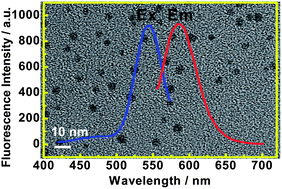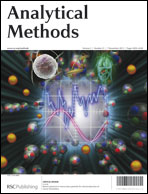Polyinosinic acid-stabilized fluorescent silver nanoclusters for sensitive detection of biological thiols
Abstract
Water-soluble fluorescent Ag nanoclusters (NCs) were prepared with the assistance of commercially available polyinosinic acid (PI) as a template, which can be greatly quenched by trace biological thiols such as cysteine (Cys), homocysteine (Hcy), and glutathione (GSH). The developed PI–Ag NCs were used for highly sensitive and selective detection of the thiols with the linear ranges of 0.1–5 μM (R2 = 0.9962) for Cys, 0.5–4 μM (R2 = 0.9967) for Hcy, and 0.05–6 μM (R2 = 0.9958) for GSH, respectively. This method was extended for the detection of total thiols in human plasma samples with acceptable recovery from 95.21% to 101.60% and satisfactory relative standard deviations (<5%).


 Please wait while we load your content...
Please wait while we load your content...